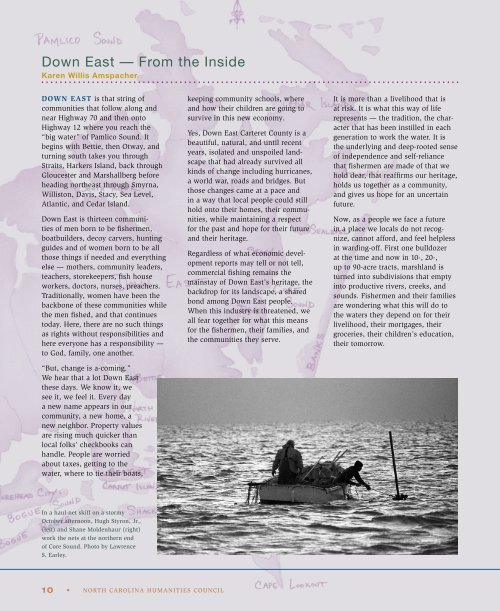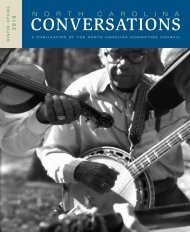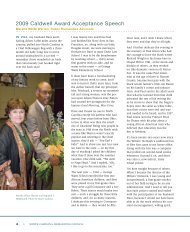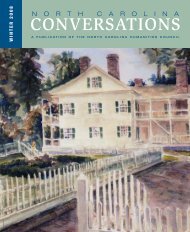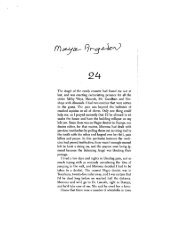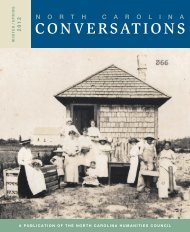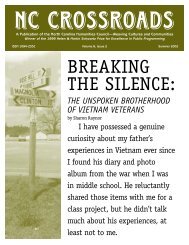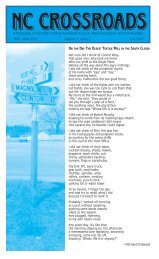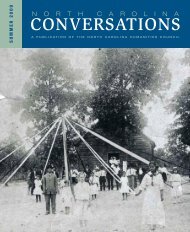North Carolina Conversations Summer-Fall 2008.pdf
North Carolina Conversations Summer-Fall 2008.pdf
North Carolina Conversations Summer-Fall 2008.pdf
- No tags were found...
You also want an ePaper? Increase the reach of your titles
YUMPU automatically turns print PDFs into web optimized ePapers that Google loves.
Down East — From the InsideKaren Willis AmspacherDown East is that string ofcommunities that follow along andnear Highway 70 and then ontoHighway 12 where you reach the“big water” of Pamlico Sound. Itbegins with Bettie, then Otway, andturning south takes you throughStraits, Harkers Island, back throughGloucester and Marshallberg beforeheading northeast through Smyrna,Williston, Davis, Stacy, Sea Level,Atlantic, and Cedar Island.Down East is thirteen communitiesof men born to be fishermen,boatbuilders, decoy carvers, huntingguides and of women born to be allthose things if needed and everythingelse — mothers, community leaders,teachers, storekeepers, fish houseworkers, doctors, nurses, preachers.Traditionally, women have been thebackbone of these communities whilethe men fished, and that continuestoday. Here, there are no such thingsas rights without responsibilities andhere everyone has a responsibility —to God, family, one another.“But, change is a-coming.”We hear that a lot Down Eastthese days. We know it, wesee it, we feel it. Every daya new name appears in ourcommunity, a new home, anew neighbor. Property valuesare rising much quicker thanlocal folks’ checkbooks canhandle. People are worriedabout taxes, getting to thewater, where to tie their boats,keeping community schools, whereand how their children are going tosurvive in this new economy.Yes, Down East Carteret County is abeautiful, natural, and until recentyears, isolated and unspoiled landscapethat had already survived allkinds of change including hurricanes,a world war, roads and bridges. Butthose changes came at a pace andin a way that local people could stillhold onto their homes, their communities,while maintaining a respectfor the past and hope for their futureand their heritage.Regardless of what economic developmentreports may tell or not tell,commercial fishing remains themainstay of Down East’s heritage, thebackdrop for its landscape, a sharedbond among Down East people.When this industry is threatened, weall fear together for what this meansfor the fishermen, their families, andthe communities they serve.It is more than a livelihood that isat risk. It is what this way of liferepresents — the tradition, the characterthat has been instilled in eachgeneration to work the water. It isthe underlying and deep-rooted senseof independence and self-reliancethat fishermen are made of that wehold dear, that reaffirms our heritage,holds us together as a community,and gives us hope for an uncertainfuture.Now, as a people we face a futurein a place we locals do not recognize,cannot afford, and feel helplessin warding-off. First one bulldozerat the time and now in 10-, 20-,up to 90-acre tracts, marshland isturned into subdivisions that emptyinto productive rivers, creeks, andsounds. Fishermen and their familiesare wondering what this will do tothe waters they depend on for theirlivelihood, their mortgages, theirgroceries, their children’s education,their tomorrow.In a haul-net skiff on a stormyOctober afternoon, Hugh Styron, Jr.,(left) and Shane Moldenhaur (right)work the nets at the northern endof Core Sound. Photo by LawrenceS. Earley.10 • <strong>North</strong> <strong>Carolina</strong> Humanities Council


